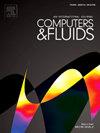Non-dimensional meshing criterion of mean flow field discretization for RANS and LES
IF 2.5
3区 工程技术
Q3 COMPUTER SCIENCE, INTERDISCIPLINARY APPLICATIONS
引用次数: 0
Abstract
When turbulent flows occur, Reynolds Average Navier–Stokes (RANS) and Large-Eddy Simulation (LES) approaches are now valuable strategies to numerically study complex systems. An open question is still to be able to define an adequate mesh, i.e. guaranteeing accuracy of the numerical simulations but limiting the number of mesh elements to limit computational cost. RANS and LES approaches differ in term of level of description of the turbulent fields, but these approaches share the same objective to obtain mean fields independent of the mesh. Based on the Reynolds equation, a new mesh size based Reynolds number, , is derived. This new criterion is the upper bound of a non-dimensional error estimation of the mean velocity field. This new criterion can also be interpreted by analogy with the Kolmogorov scale, . Indeed, can be interpreted as the scale where the instantaneous dynamic is dominated by (molecular) diffusive effects, leading to the Kolmogorov Reynolds number, . Similarly, will be close to 1 at scale where molecular and turbulent diffusive effects dominate the mean field dynamic. This allows to define the local mesh size to guarantee a correct discretization of the mean field. This criterion is applied in various flow configuration for LES, with and without law of the wall, as well as RANS simulations with great accuracy. In practice, it is found that the value appears indeed as a good compromise in terms of number of elements and precision. This allows to easily obtain an adequate mesh for the mean flow velocity field, without a priori knowledge of the flow dynamic.
RANS和LES平均流场离散化的无量纲网格划分准则
当湍流发生时,雷诺平均纳维-斯托克斯(RANS)和大涡模拟(LES)方法现在是数值研究复杂系统的有价值的策略。一个悬而未决的问题仍然是如何定义一个适当的网格,即保证数值模拟的准确性,但限制网格元素的数量,以限制计算成本。RANS和LES方法在湍流场的描述水平上有所不同,但这些方法都有相同的目标,即获得独立于网格的平均场。在雷诺方程的基础上,导出了一种新的基于雷诺数的网格尺寸ReΔ。这个新准则是平均速度场的无因次误差估计的上界。这个新的判据也可以用柯尔莫哥洛夫尺度η来解释。事实上,η可以解释为瞬时动力学由(分子)扩散效应主导的尺度,导致柯尔莫哥罗夫雷诺数Reη ~ 1。同样,ReΔ在尺度Δ将接近1,其中分子和湍流扩散效应主导平均场动力学。这允许定义局部网格大小,以保证平均场的正确离散化。该判据适用于具有壁面规律和不具有壁面规律的LES的各种流动形态,以及具有较高精度的RANS模拟。在实践中,发现值ReΔ ~ 1在元素数量和精度方面确实是一个很好的折衷。这样可以很容易地获得平均流速场的适当网格,而无需先验的流动动力学知识。
本文章由计算机程序翻译,如有差异,请以英文原文为准。
求助全文
约1分钟内获得全文
求助全文
来源期刊

Computers & Fluids
物理-计算机:跨学科应用
CiteScore
5.30
自引率
7.10%
发文量
242
审稿时长
10.8 months
期刊介绍:
Computers & Fluids is multidisciplinary. The term ''fluid'' is interpreted in the broadest sense. Hydro- and aerodynamics, high-speed and physical gas dynamics, turbulence and flow stability, multiphase flow, rheology, tribology and fluid-structure interaction are all of interest, provided that computer technique plays a significant role in the associated studies or design methodology.
 求助内容:
求助内容: 应助结果提醒方式:
应助结果提醒方式:


